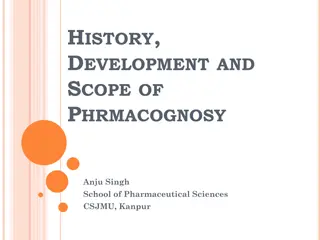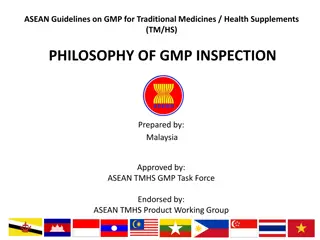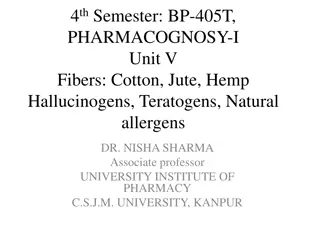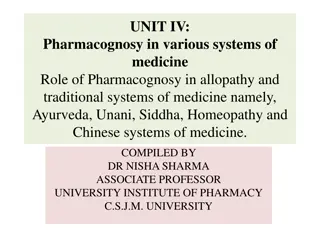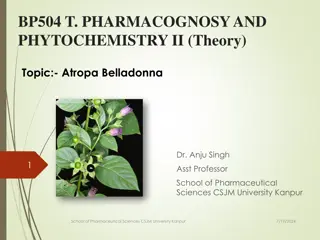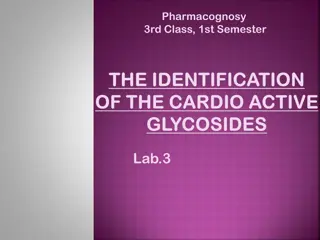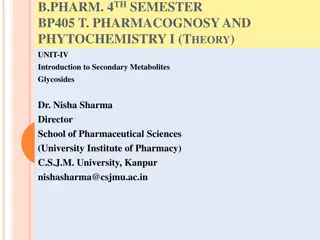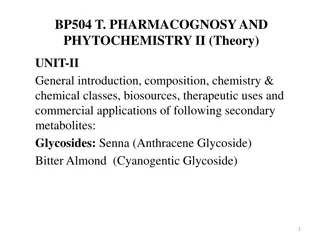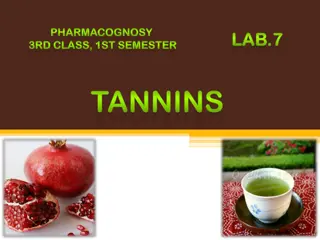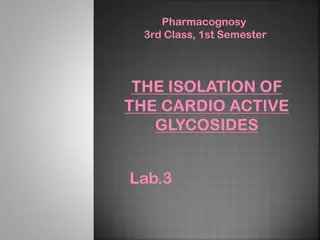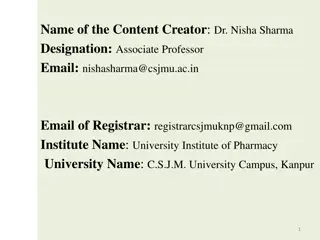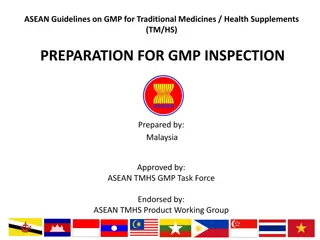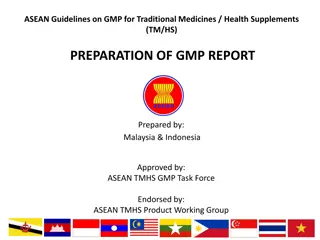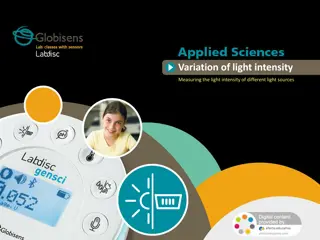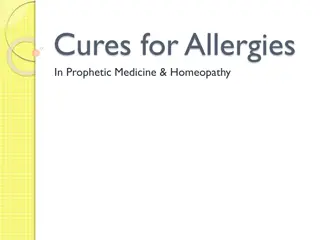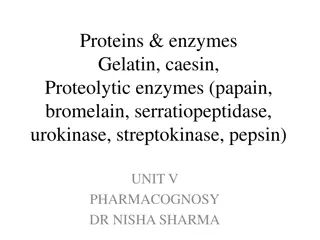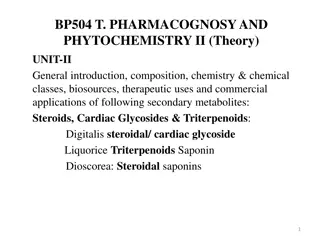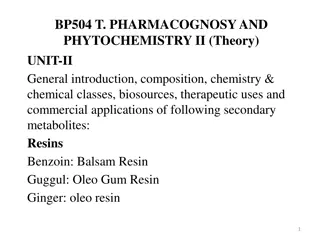Introduction to Practical Pharmacognosy: Study of Medicines from Natural Sources
Pharmacognosy is the study of medicines derived from natural sources, exploring drugs from plants through the lenses of botany, chemistry, and pharmacology. This includes the classification of vegetable drugs based on taxonomic, chemical, and morphological characteristics. Understanding key points for plant drugs and examples like Coffee, Glycyrrhiza, and Senna are essential in practical pharmacognosy experiments, including morphological and microscopic examination of crude drugs. Examining cell inclusions and differentiating characteristics like cell walls and epidermis play a crucial role in this field.
Download Presentation

Please find below an Image/Link to download the presentation.
The content on the website is provided AS IS for your information and personal use only. It may not be sold, licensed, or shared on other websites without obtaining consent from the author. Download presentation by click this link. If you encounter any issues during the download, it is possible that the publisher has removed the file from their server.
E N D
Presentation Transcript
Practical pharmacognosy Introduction for practical experiment
Pharmacognosy is the study of medicines derived from natural sources. The word" pharmacognosy "is derived from the Greek words pharmakon(drug). The study of drugs from plants includes the subjects of Botany Chemistry Pharmacology.
Classification of vegetable drugs for study Taxonomic: Families, Genera, and Species. Chemical e.g. alkaloids, glycosides, V.O. etc. Morphological: either organized drugs (leaves, flowers and seeds) or unorganized (extracts, gums, oils .etc.).
The most important points you have to recognize for plant drugs The Botanical name. Family name. Local name. Part used. Active compounds. Basic structure. Dosage form. Therapeutic use.
Coffee Botanical name: Coffea arabica Family name: Rubiacae Local name: Part used: Coffee seeds Active compound: caffeine Basic structure: H.W Therapeutic use: Central stimulant
Glycyrrhiza Botanical name: Glycyrrhiza glabra Family name: Leguminosae Local name: Part used: Root Active compound: Saponin glycoside (glycyrrhizin). Basic structure: H.W Therapeutic use: Demulcent, expectorant.
Senna Botanical name: Cassia acutifolia Family name: Leguminosae Local name: Part used: leaves and pods. Active compound: Anthraquinone glycoside Basic structure: H.W Therapeutic use: cathartic or laxative.
Morphological and microscopically examination of crude drugs and cell inclusions Cell differentiation: The cell wall ex: cellulose wall. The epidermis Epidermal trichomes
Epidermis Single layer of cells covering the whole plant Ex.: Strait walled epidermis in Senna leaves waxy walled in Belladonna leaves beaded wall in digitalis. stomata : (refers to the minute pores that can be found on the epidermis of a leaf,These pores vary in size and allow for the movement of water and gases with environment).
Epidermal Trichomes 1-Covering Trichomes such as: Unicellular From Senna leaves. Multicellular unbranched From Digitalis leaves. 2-Glandular Trichomes Unicellular head From Digitalis leaves Multicellular head From Peppermint leaves
Microscopically identification for starch + calcium oxalate: The determination of the size, shape and relative positions of the different cell and tissues. The determination of chemical nature of the cell walls. The determination of the form and chemical nature of cell content.
Starch Dusting powder (in which adsorbent properties are important). Tablet disintegrate. Lubricant for surgeons gloves (sterilizable maize starch) Antidote in treatment of iodine poisoning. Skin emollient, basis for enemas
Macroscopically character Starch occurs in irregular, angular masses or as a white powder. It is insoluble in cold water but forms a colloidal solution on boiling of water, the solution forming a translucent jelly on cooling. A starch mucilage is colored deep blue with solution of iodine. when starch is heated with water the granules first swells and then undergo gelatinization. maize starch is neutral but other commercial starches show an acid ( wheat and potato) or alkaline (rice) reaction.
Procedure: Prepare starch solution: 2gm of starch in 200ml D.W -OR- we can prepare starch from natural source such as rice , potato by boiling 2gm of plant in 200ml D.W. Detection of starch by iodine test : 1ml of starch solution + 1ml of iodine positive result give bluish black color). Also: we can detect any plant part contain starch by adding iodine solution directly on the plant part such as potato
Examination of starch under microscope For this purpose take a little amount of plant powder and mixed it with glycerin-alcohol solution . Then take 1 drop from this solution (starch + glycerin-alcohol solution). Put it on slide then cover it with cover slide, Also we can use starch with iodine test then Exam under microscope.
Calcium Oxalate Calcium oxalate can crystalize into three forms: Monohydrate Dihydrate Trihydrate Solubility: insoluble in water Chemical formula of Ca. oxalate: CaC2O4
plant source of ca.oxalate 1-Cinnamon Cinnamomum cassia 2- Oleander Nerium oleander Not: Cinnamon using glycerin-alcohol solution, as in starch.
Procedure The leaves of the plant (oleander) were taken, then washed properly and cut into small bits. A transverse section of the leaf was treated with sodium hypochloride for bleaching Stained with safranin dye and observed for the presence of calcium oxalate crystals


